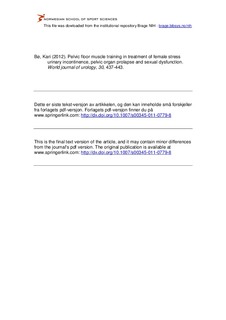| dc.contributor.author | Bø, Kari | |
| dc.date.accessioned | 2012-09-28T12:31:50Z | |
| dc.date.available | 2012-09-28T12:31:50Z | |
| dc.date.issued | 2011-10-09 | |
| dc.identifier | Seksjon for idrettsmedisinske fag / Department of Sports Medicine | |
| dc.identifier.citation | World Journal of Urology. 2012, 30(4), 437-443 | no_NO |
| dc.identifier.issn | 0724-4983 | |
| dc.identifier.uri | http://hdl.handle.net/11250/170978 | |
| dc.description | I Brage finner du siste tekst-versjon av artikkelen, og den kan inneholde ubetydelige forskjeller fra forlagets pdf-versjon. Forlagets pdf-versjon finner du på www.springerlink.com: http://dx.doi.org/10.1007/s00345-011-0779-8 / In Brage you'll find the final text version of the article, and it may contain insignificant differences from the journal's pdf version. The original publication is available at www.springerlink.com: http://dx.doi.org/10.1007/s00345-011-0779-8 | no_NO |
| dc.description.abstract | Objectives
The objectives of the present review was to present and discuss evidence for pelvic floor muscle (PFM) training on female stress urinary incontinence (SUI), pelvic organ prolapse (POP) and sexual dysfunction.
Methods
This manuscript is based on conclusions and data presented in systematic reviews on PFM training for SUI, POP and sexual dysfunction. Cochrane reviews, the 4th International Consultation on Incontinence, the NICE guidelines and the Health Technology Assessment were used as data sources. In addition, a new search on Pubmed was done from 2008 to 2011. Only data from randomized controlled trials (RCTs) published in English language is presented and discussed.
Results
There is Level 1, Grade A evidence that PFM training is effective in treatment of SUI. Short-term cure rates assessed as <2 g of leakage on pad testing vary between 35 and 80%. To date there are 5 RCTs showing significant effect of PFM training on either POP stage, symptoms or PFM morphology. Supervised and more intensive training is more effective than unsupervised training. There are no adverse effects. There is a lack of RCTs addressing the effect of PFM training on sexual dysfunction.
Conclusions
PFM training should be first line treatment for SUI and POP, but the training needs proper instruction and close follow-up to be effective. More high quality RCTs are warranted on PFM training to treat sexual dysfunction. | no_NO |
| dc.language.iso | eng | no_NO |
| dc.publisher | Springer | no_NO |
| dc.subject | pelvic floor muscle training | no_NO |
| dc.subject | pelvic organ prolapse | no_NO |
| dc.subject | strength | no_NO |
| dc.subject | sexual dysfunction | no_NO |
| dc.subject | stress urinary incontinence | no_NO |
| dc.title | Pelvic floor muscle training in treatment of female stress urinary incontinence, pelvic organ prolapse and sexual dysfunction | no_NO |
| dc.type | Journal article | no_NO |
| dc.type | Peer reviewed | no_NO |
| dc.subject.nsi | VDP::Medical disciplines: 700 | no_NO |
| dc.source.pagenumber | 437-443 | no_NO |
| dc.source.volume | 30 | no_NO |
| dc.source.journal | World Journal of Urology | no_NO |
| dc.source.issue | 4 | no_NO |
